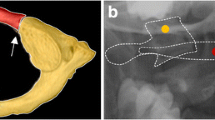Abstract
Ligamentous cervical injury may not be apparent when viewed with static cervical spine radiography (CSR). Dynamic (flexion-extension) views of the cervical spine may aid in the identification of such injury. A retrospective descriptive study was carried out between July 1, 1990, and June 30, 1994, in an academic emergency department averaging 60,000 patient visits (of which 20% are pediatric) per year. The subjects were pediatric blunt trauma patients, 0–18 years of age. CSR was performed in the static (lateral, anteroposterior, odontoid) and dynamic (flexion and extension) views.
One hundred thirty-seven patients (53% male; mean age, 12.9 years) met entry criteria. Mechanisms of injury included motor vehicle accident (57 patients, 43%), fall from a height (56 patients, 42%), and direct trauma (20 patients, 15%). Indications for CSR included a traumatic mechanism, the complaint of neck pain, and posterior midline neck tenderness on examination in all cases; abnormal static CSR was also an indication in 40 cases (30%). Results of static CSRs were normal in 93 patients (70%), all of whom had a normal dynamic CSR. Static CSRs were abnormal in 40 patients (30%), of whom 33 had a normal dynamic CSR. The 7 patients (5%) with an abnormal dynamic CSR had disruption of the lines of cervical contour (6), and/or reversal of lordotic curve (2) noted on the static CSR. No patient required invasive spine surgery, and all were discharged with a satisfactory neurologic outcome after hospital admission. No complications of dynamic CSR use occurred. Among patients who are alert and communicative, dynamic CSR is safe and assists in the evaluation of pediatric blunt neck trauma when patients present with pain, midline tenderness, and abnormal static CSR.
Similar content being viewed by others
References
Ruge SR. Pediatric spinal injury: the very young. J Neurosurg 1988;68:25–30.
Hadley MN, Zabramski JM, Browner CM, et al. Pediatric spinal trauma: review of 122 cases of spinal cord and vertebral column injuries. J Neurosurg 1988;68:18–24.
Jaffe DM, Binns H, Radkowski MA, et al. Developing a clinical algorithm for early management of cervical spine injury in child trauma victims. Ann Emerg Med 1987;16:270–6.
Rachesky I, Boyce T, Duncan B, et al. Clinical prediction of cervical spine injuries in children: radiographic abnormalities. Am J Dis Child 1987;141:199–201.
Bonadio WA. Cervical spine trauma in children. Part I. General concepts, normal anatomy, radiographic evaluation. Am J Emerg Med 1993;11:158–65.
Bonadio WA. Cervical spine trauma in children. Part II. Mechanisms and manifestations of injury, therapeutic considerations. Am J Emerg Med 1993;11:256–78.
Fesmire FM, Luten R. The pediatric cervical spine: developmental anatomy and clinical aspects. J Emerg Med 1989;7:133–42.
Lewis LM, Docherty M, Ruoff BE, Fortney JP, Keltner RA, Britton P. Flexion-extension views in the evaluation of cervical spine injuries. Ann Emerg Med 1991;20:117–21.
Swischuk LE. Anterior displacement of C2 in children: physiologic or pathologic. Radiology 1977;122:759–63.
Hoffman JR, Schriger DL, Mower W, Luo JS, Zucker M. Low-risk criteria for cervical-spine radiography in blunt trauma: a prospective study. Ann Emerg Med 1992;21:1454–60.
Fischer RP. Cervical radiographic evaluation of alert patients following blunt trauma. Ann Emerg Med 1984;13:905–7.
Bachulis BL, Long WB, Hynes GD, et al. Clinical indications for cervical spine radiographs in the traumatized patient. Am J Surg 1987;153:473–7.
Ringeberg BJ, Fisher AK, Urdaneta LF, et al. Rationale for ordering of cervical spine radiographs following trauma. Ann Emerg Med 1988;17:792–6.
Freemeyer B, Knopp R, Piche J, et al. Comparison of five-view and three-view cervical spine series in the evaluation of patients with cervical spine trauma. Ann Emerg Med 1989;18:818–21.
Streitwieser DR, Knopp R, Wales LR, et al. Accuracy of standard radiographic views in detecting cervical spine fractures. Ann Emerg Med 1983;12:538–42.
Wales LR, Knopp RK, Morishima MS. Recommendations for evaluation of the acutely injured cervical spine: a clinical radiologic algorithm. Ann Emerg Med 1980;9:422–8.
Brady WJ, Moghtader J, Young JS, et al. Flexion-extension cervical spine radiography in adult blunt trauma [abstr]. Ann Emerg Med 1997;30:406.
Barkin RM. Pediatric emergency medicine: concepts and clinical practice. St. Louis: Mosby Year Book, 1992.
Bohrer SP, Chen YM, Sayers DG, Cervical spine flexion patterns. Skeletal Radiol 1990;19:521–5.
Dvorák J, Panjabi MM, Grob D, et al. Clinical validation of functional flexion/extension radiographs of the cervical spine. Spine 1993;18:120–7.
Pennecot GF, Leonard P, Des Gachons P, et al. Roentgenographical study of the stability of the cervical spine in children. J Pediatr Orthop 1984;4:346–52.
Pennecot, GF, Gouraurd D, Hardy JR, Pouliquen JC. Traumatic ligamentous instability of the cervical spine in children. J Pediatr Orthop 1984;4:339–45.
Orenstein JB, Klein BL, Gotschall CS, et al. Delayed diagnosis of pediatric cervical spine injury. Pediatrics 1992;89:1185–8.
Dietrich AM, Ginn-Pease ME, Bartkowski HM, King DR. Pediatric cervical spine fractures: predominantly subtle presentation. J Pediatr Surg 1991;26:995–1000.
Fleisher GR, Ludwig S. Textbook of pediatric emergency medicine, 3rd ed. Baltimore: Williams & Wilkins, 1993.
Ogden JA. Skeletal injury in the child. Philadelphia: Saunders, 1990.
Rosen P, Barkin R. Emergency medicine: concepts and clinical practice. 4th ed. St. Louis: Mosby Year Book, 1998.
Fricker A, Gächter A. Lateral flexion/extension radiographs: still recommended following cervical spinal injury. Arch Orthop Trauma Surg 1994;113:115–6.
MacDonald RL, Schwartz ML, Mirich D, et al. Diagnosis of cervical spine injury in motor vehicle crash victims: how many X-rays are enough? J Trauma 1990;30:392–7.
Author information
Authors and Affiliations
Rights and permissions
About this article
Cite this article
Woods, W.A., Brady, W.J., Pollock, G. et al. Flexion-extension cervical spine radiography in pediatric blunt trauma. Emergency Radiology 5, 381–384 (1998). https://doi.org/10.1007/BF02749184
Issue Date:
DOI: https://doi.org/10.1007/BF02749184




